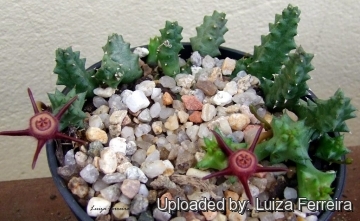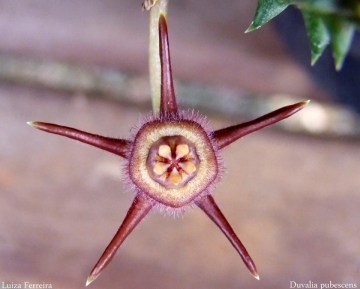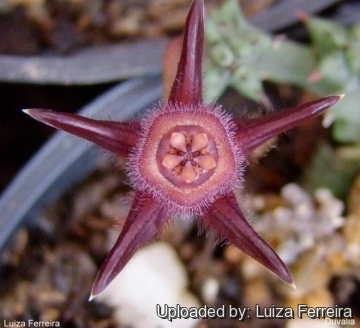
Duvalia caespitosa subs. pubescens Photo by: Luiza Ferreira
Origin and Habitat: Southern Namibia, Republic of South Africa (Northern Cape. Western Cape).
Habitat and ecology: Duvalia caespitosaSN|26498]]SN|26498]] subs. pubescens is in endemic to semiarid regions north of the Olifants River which receive only winter rainfall. It is closely related to Duvalia caespitosaSN|26498]]SN|26498]] (from areas south of the Olifants River which receive mostly summer rainfall), from which it is distinguishable by its unique indumentum of the corolla and its allopatric distribution within the northern winter-rainfall area.
Synonyms:
See all synonyms of Duvalia caespitosa
Common Names include:
GERMAN (Deutsch): Aasblume
Description: Only some authors consider Duvalia pubescensSN|26498]]SN|26543]] to be a good species on its own; the others classify it as Duvalia caespitosaSN|26543]]SN|26498]] subs. pubescens, regardless to classification it is clearly distinguishable by its pubescent corolla surface from which it is named.
Habit: It is a mat-forming, perennial-succulent, with procumbent or decumbent stems with 4 to 5 indistinctly ribs.
Stems: 1.5-5 (or more under cultivation) cm long, (7-)8-16(-22) mm thick, ovoid to cylindrical, obtusely 4–5-angled, dull dark green. Edges with horizontal stout conical teeth 2-4 mm long.
Leaves: Rudimentary 1-2 mm long.
Flowers: 2–4, procumbent to slightly erect with foetid odour, successively developed from the upper or central parts of the young shoots. Pedicels 8-12(-25) mm long, about 2 mm thick. Sepals 2-4 mm long, ovate, very acute or acuminate. Corolla 18-25 to nearly 32 mm in diameter, (pale) maroon, brown or deep purple, pubescent on the whole of the inner face, but usually more densely on the annulus than on the lobes, with minute short soft simple hairs 0.2-1 mm long, dark chocolate brown. Corolla lobes very much spreading, recurved at the tips, 6-13 mm long, 3-7 mm wide, margins vertically folded back (replicate) to the base into vertical plates 2-2.5 mm deep at the base, upper surface (in some cases only basally) finely hairy. Hairs simple, erect, white or purple 0.5-1.4 mm, margin not ciliate. Annulus 7-12 mm in diameter, 1.5-3 mm high, circular to very obtusely or obscurely pentagonal, occasionally spotted, with vertical sides, and the sinuses between the lobes reflexed to the pedicel, finely hairy. Hairs 0.3-1 mm long. Outer corona 4-5 mm in diameter, pentagonal, dull reddish-brown, orange-brown or maroon (also white in Namibia), , disc 4.5-6 mm in diameter. Outer corona-lobes 1-2.4 long, 1.2-2 mm thick. Pollinia 0.35-0.45 x 0.25-0.3 mm.
Fruits (paired follicles): 8-14 cm long.
Seeds: 4.5 -5.5 x 3 mm.
Subspecies, varieties, forms and cultivars of plants belonging to the Duvalia caespitosa group
 Duvalia caespitosa (Masson) Haw.: has purple-brown star shaped flowers with five fleshy, narrow 'petals'. It is extremely variable and forms a complex. Distribution: Northern, Western and Eastern Cape(summer rainfall areas).
Duvalia caespitosa (Masson) Haw.: has purple-brown star shaped flowers with five fleshy, narrow 'petals'. It is extremely variable and forms a complex. Distribution: Northern, Western and Eastern Cape(summer rainfall areas). Duvalia caespitosa var. compacta (Haw.) Meve: has smaller stems and flowers. Distribution: Northern Cape, Western Cape, Eastern Cape: Namaqualand, Great Karoo.
Duvalia caespitosa var. compacta (Haw.) Meve: has smaller stems and flowers. Distribution: Northern Cape, Western Cape, Eastern Cape: Namaqualand, Great Karoo. Duvalia caespitosa subs. pubescens (N.E.Br.) Bruyns: has pubescent corolla surface. Distribution: Southern Namibia, RSA(Northern Cape. Western Cape)north of the Olifants (winter rainfall areas).
Duvalia caespitosa subs. pubescens (N.E.Br.) Bruyns: has pubescent corolla surface. Distribution: Southern Namibia, RSA(Northern Cape. Western Cape)north of the Olifants (winter rainfall areas).- Duvalia caespitosa subs. vestita (Meve) Bruyns
 Duvalia reclinata (Masson) Haw.: not readily distinguishable from the type, if not for the geographical provenance. Distribution: Cape Province, Central regions and in the coast region near Ladismith.
Duvalia reclinata (Masson) Haw.: not readily distinguishable from the type, if not for the geographical provenance. Distribution: Cape Province, Central regions and in the coast region near Ladismith.
Bibliography: Major references and further lectures:
1) N. E. Brown “Flora Capensis”, Vol 4, 1909
2) Focke Albers, Ulrich Meve “Illustrated Handbook of Succulent Plants: Asclepiadaceae: Asclepiadaceae” Volume 4 Springer, 2002
3) Hermann Jacobsen “Abromeitiella to Euphorbia” Blandford Press, 1960
4) Foden, W. & Potter, L. 2005. Duvalia caespitosa (Masson) Haw. subsp. pubescens (N.E.Br.) Bruyns. National Assessment: Red List of South African Plants version 2014.1. Accessed on 2015/02/08
5) Meve, U. 1997. “The genus Duvalia (Stapelieae): stem-succulents between the Cape and Arabia.” Pl. Syst. Evol., Suppl. 10: 1–132.
 Duvalia caespitosa subs. pubescens Photo by: Luiza Ferreira
Duvalia caespitosa subs. pubescens Photo by: Luiza Ferreira Duvalia caespitosa subs. pubescens Photo by: Luiza Ferreira
Duvalia caespitosa subs. pubescens Photo by: Luiza Ferreira Duvalia caespitosa subs. pubescens Photo by: Luiza Ferreira
Duvalia caespitosa subs. pubescens Photo by: Luiza FerreiraSend a photo of this plant.The gallery now contains thousands of pictures, however it is possible to do even more. We are, of course, seeking photos of species not yet shown in the gallery but not only that, we are also looking for better pictures than those already present.
Read More... Cultivation and Propagation: Duvalia caespitosa subs. pubescens is an easy obliging blooming plant when mature, that it is happy in any average succulent house.
Potting:Since roots are quite shallow, use a soft and incoherent cactus mix or add extra perlite or pumice to regular soil potting soil, and clay pots help the plants to dry out between watering.
Waterings: Duvalia require moderately watering through the growing season but enjoy plenty of water and some fertiliser in hot weather, this helps them to flower freely. Water more sparingly in winter according to temperatures. But, as with most asclepiads, it is unwise to leave them wet in cold weather.
Fertilization: Fertilizers for succulent plants must be rich in potassium, but poor in nitrogen, to avoid the plants from developing excess vegetation, which is easily attacked by fungal diseases.
Sun Exposure: As with many succulents, they prefer to grow in the light shade of scrubby shrubs or between rocks where they get some shade during the day. In summer it is advisable to position this plant in a partially shady place, where it is exposed to direct sunlight only during the coolest hours of the day.
Hardiness: These plants don't like cold weather, therefore in the Spring it is best to set them outside only when the temperatures are above 15°C. Can endure temperatures below 5°C for short period, but only if the soil stays completely dry.
Pest and diseases: Duvalia species vary in their susceptibility to rotting, but are generally fairly easy to grow, especially if kept pest-free. They are very susceptible to stem and root mealy bugs, and damage from these may well initiate fungal attack. If you do have problems with a stem or with basal rotting, you can reliably isolate the healthy parts, dry them off, and re-root them in moist compost.
Cultural Practices: Re-pot every 2 years.
Propagation: Easiest with stem cuttings. Allow cuttings to dry a day before planting. Stems must be laid (Not buried) on gritty compost and will then root from the underside of the stems. It can also be increased from seeds sowing in spring in moist, sandy peat moss. Barely cover seeds. Seeds germinate quickly.














